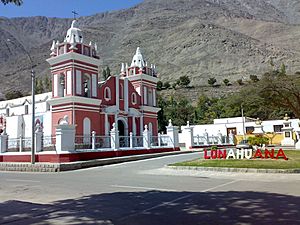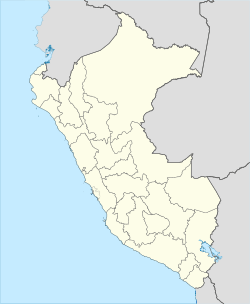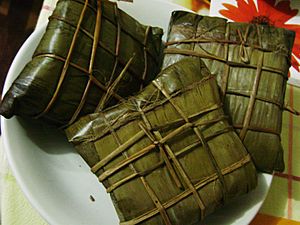Lunahuaná facts for kids
Quick facts for kids
Lunahuaná
|
|
|---|---|
|
Town
|
|

Plaza de Armas of Lunahuaná
|
|
| Country | |
| Region | Lima |
| Province | Cañete |
| District | Lunahuaná |
| Established | August 4, 1821 |
| Area | |
| • Total | 500.33 km2 (193.18 sq mi) |
| Elevation | 476 m (1,562 ft) |
| Population
(2017)
|
|
| • Total | 4,393 |
| • Density | 8.7802/km2 (22.7406/sq mi) |
| Time zone | UTC-5 (PET) |
| UBIGEO |
150508
|
Lunahuaná is a small town in the Cañete Province in Peru. It is located about 187 km south of Lima. The town sits in the Lunahuaná valley, right by the Cañete River.
Because of its beautiful natural scenery, Lunahuaná is a very popular place to visit. Many Peruvians and tourists from other countries come here. In 2017, about 4,393 people lived in Lunahuaná.
Contents
Delicious Local Food in Lunahuaná
When you visit Lunahuaná, you can try many special local dishes. These foods are often cooked in traditional clay pots and on wooden stoves. Some popular meals include:
- Shrimp prepared in different ways
- Chola soup
- Duck with rice
- Tamales (a dish made of masa, usually corn-based, steamed in a leaf wrapper)
- Chicharrones (fried pork)
- Adobo pork
- Carapulcra (a thick stew of dried potatoes and meat)
- Pachamanca (a traditional Peruvian dish cooked with hot stones)
- Guinea pigs and rabbits
Lunahuaná's Rich History
The history of Lunahuaná goes back a very long time. The first people lived in this area between 6000 and 2000 BC. This was long before the famous Inca Empire existed.
Lunahuaná and the Inca Empire
Lunahuaná became a very important city during the time of the Inca Empire. It was the second largest city under the rule of the Inca leader Pachacútec. The name Lunahuaná might come from the Quechua words runa (meaning man or mankind) and wasi (meaning punishment).
The Lunahuaná valley was a challenging place for the Inca to conquer. The local people, called the Guarco (or Huarco), lived there first. The wild Cañete River made it hard for the Inca armies to advance. It took them three to four years to finally take control.
You can still see the ruins of the Inka Wasi fortress today. It is about eight kilometers from Lunahuaná. This fortress shows where the Inca successfully conquered the area. A famous Inca leader, Tupac Yupanqui, was part of these battles.
Modern Founding of Lunahuaná
Lunahuaná was officially established as a market town in 1821. This happened under the leadership of Don José de San Martín, a key figure in Peru's independence.
Fun Places to Visit in Lunahuaná
Lunahuaná has many interesting spots and activities for visitors.
Historical and Natural Sights
In the center of the town, you'll find a beautiful Catholic church. It is located in the main square. The Franciscans, a religious order, built this church in 1690. In 1972, it was recognized as a historical monument.
The main attraction of Lunahuaná is the Cañete River. It's a great place for exciting whitewater boat tours, also known as rafting. Other popular outdoor activities include:
- Hiking on scenic trails
- Mountain biking through the valley
- Paragliding for amazing views
- Fishing in the river
Exploring Inka Wasi
The ancient ruins of Inka Wasi are about eight kilometers from Lunahuaná. This complex is divided into three main parts:
- The Inca Area: This section was likely where the Inca people lived.
- The Religious Center: Called Qullqa, this area was used for religious ceremonies.
- The Inca Palace: This was the royal residence of the Inca leader.
Discovering the Pisco Trail
In 2015, Lunahuaná started an official pisco trail. This was the first of its kind in the Lima Region. Pisco is a type of grape brandy made in Peru. This trail joins four other pisco trails in other parts of Peru, like Ica and Arequipa.
The pisco trail in Lunahuaná includes five wineries. These wineries are approved by the Ministry of Foreign Trade and Tourism. They offer tours and tastings.
- D’La Cruz Winery: This is the first stop on the trail. It was founded in 2002.
- El Sol Winery: Next, you'll find El Sol, which started in the early 1900s.
- Santa María Winery: This winery has a long family history, going back to 1929.
- De la Motta Winery: Created in 2005, this winery is also part of the trail.
- Viña Los Reyes: This is the oldest winery in Lunahuaná, dating back to 1896.
All the wineries in the Cañete district have special rooms for tasting pisco. They also use modern technology and some even have places to stay or restaurants.
Images for kids
See also
 In Spanish: Lunahuaná para niños
In Spanish: Lunahuaná para niños





